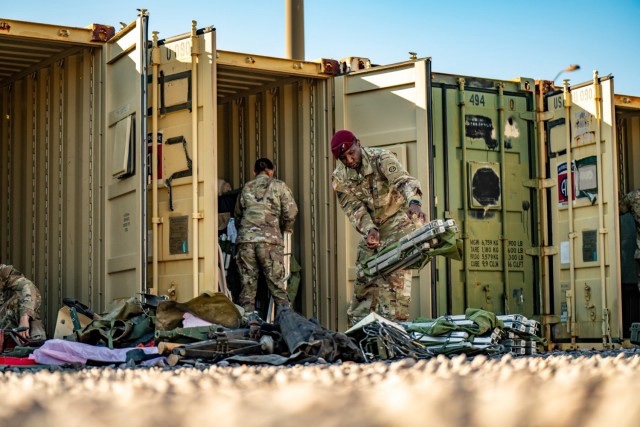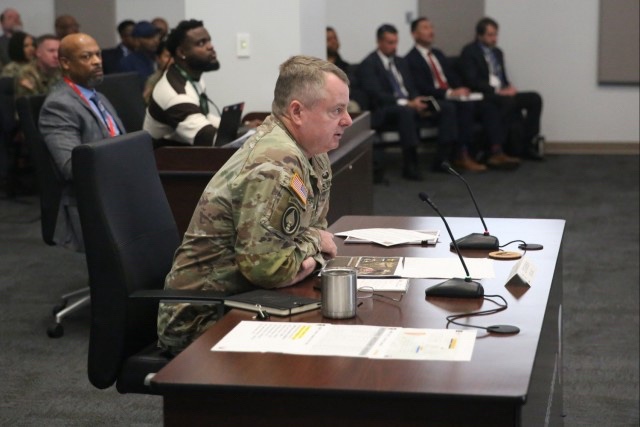
REDSTONE ARSENAL, Ala. — Senior leaders from around the Army met both virtually and in-person for the Army Modernization Equipping Conference, Dec. 4-7 at Army Materiel Command headquarters.
The AMEC, held semiannually, brought together leadership from the four major Army commands and Headquarters Department of the Army staff sections to synchronize equipment distributions and displacements in line with Army priorities and Regionally Aligned Readiness and Modernization Model phases to achieve cohesion throughout the Army.
“We’ve been busy supporting allies and partners in multiple theaters, and that’s impacting the Army’s equipping decisions and enterprise,” said Lt. Gen. Chris Mohan, AMC deputy commanding general.

He hailed the AMEC as a key Army synchronization conference and for being an important forum that provides the chance to review equipment fielding and modernization while resolving friction points.
In addition to equipping and modernization discussions, the AMEC also addressed special topics, including Second Destination Transportation, the Decision Support Tool and an update on the Rapid Removal of Excess pilot program, which wraps up Dec. 15 at Fort Liberty, North Carolina and Fort Stewart, Georgia.
“We’re here to support the Chief of Staff of the Army’s emphasis on continuing transformation and building the Army of 2030,” said Bryan Shone, Army G-8 deputy director of program analysis and evaluation.
Chief of Staff of the Army Gen. Randy George charged Army Materiel Command to pilot a new program aimed at increasing equipment on hand readiness through focused fielding, lateral transfers and divestiture. Since October, active units at both installations have been turning in items ranging from small electronics and general supplies to military vehicles at their respective Modernization, Displacement and Repair Sites.
“Lessons learned from the R2E pilot program are being captured by AMC, Army Sustainment Command, 3rd Expeditionary Sustainment Command and U.S. Army Forces Command, all of which have a stake in unburdening our Soldiers,” said Eric Cowan, AMC divestiture team lead.
Cowan discussed the potential expansion of the pilot program and the transfer options for collected equipment, including the potential transfer of equipment to U.S. Army Security Assistance Command for partner nation opportunities for foreign military sales.
Both Mohan and Lt. Gen. Paul Calvert, FORSCOM deputy commanding general, praised the pilot program as well as 3rd ESC and the Army Field Support Battalions at Fort Liberty and Fort Stewart for rapidly identifying and collecting thousands of pieces of equipment.
“We’re going to take a pause to capture what we learned and apply it to the next iteration of the pilot program,” Calvert said. “But ultimately, we’re seeing that we’ve met the intent of unburdening the Soldier.”
The Army is using data and analytics to not only capture the amount of excess equipment in the field, but also to extend the predictability of logistics into the future for combatant commands in the European and Indo-Pacific theaters. By having better visibility of equipment and the condition it is in, AMC can predict MDRS and Organic Industrial Base operations one to two years ahead of time.
As the AMEC concluded, the resounding sentiment from participants was one of commitment to modernization and strategic alignment, underscoring the Army’s dedication to staying at the forefront of military sustainment.
“As we continue to synchronize with other big Army-wide conferences, the AMEC is only going to get better,” Mohan said. “It will continue to be the driving force behind senior leader decisions.”
Story and one photo by Lindsay Grant
With one photo by SGT Vincent Levelev


Lt Gen. Mohan and I go way back to when he was my Company Commander. No better champion for soldiers.